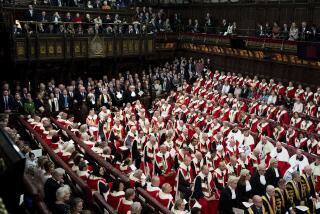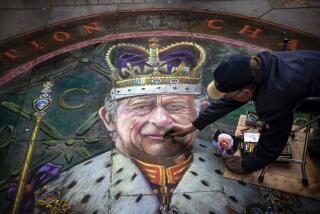Britain’s House of Lords Overflowing for Its Debut on Live Television
- Share via
LONDON — The historic first day of televising a daily session of the House of Lords was disrupted Wednesday by striking miners demonstrating in the visitors’ gallery, but the British audience never saw the disturbance.
Under the rules governing television, the cameras were not trained on the shouting miners in the gallery but instead remained fixed on the floor of the upper house of the British Parliament. The demonstrators, protesting government plans to close unprofitable mines, were quickly removed, and Britons soon got the first direct view most of them had ever had of the stately proceedings of the House of Lords.
They saw the members, who are all nobles of the realm, speak in calm and measured tones and polite address--”My noble friend.” Their lordly manner contrasts sharply with the more familiar hurly-burly of “another place,” the lords’ phrase for the House of Commons at the other end of the Palace of Westminster.
Viewers found the lords assembled in business suits rather than ermine robes, which they use only on high ceremonial occasions. The exceptions were the lord chancellor, Lord Hailsham, who as Speaker of the house wore his black silk robes and full-bottomed wig and sat on the woolsack in front of the queen’s throne, and his similarly garbed attendants--the yeoman usher, who carried the huge mace, symbol of the queen’s authority, and the “black rod,” Air Chief Marshal John Gingell, the official responsible for security of the house.
By the time the show began in mid-afternoon, all the red leather benches in the chamber were jammed. Some members squatted on the steps of the throne, having been less wise than others who arrived early to ensure seats for the occasion. One early arrival, who decided to duck out for a cup of tea before the session started, left a note reading: “Please don’t pinch my seat.”
The 90-by-45-foot chamber does not hold enough benches to seat all the lords at once, for the simple reason that many lords do not attend sessions for years at a time. There are 936 potentially active peers--401 Conservatives, 128 Laborites, 40 Liberals, 39 Social Democrats and 248 cross-benchers or independents--and a normal session draws only about 300 of them.
The television debut, however, brought out a crowd of would-be media stars. And it led to what may have been a record 47 speakers in the major debate of the day, a Labor Party motion to insist that the government do more to reduce unemployment.
The speakers came from the government benches--called the “spiritual side” because bishops, who are known as the lords spiritual, sit there with the ruling party’s lords temporal. And they came from the opposition benches and from the cross-bench.
Each speech ran as long as 20 minutes, and as the debate wore on and the novelty of television wore off, the lords began drifting away--some into sleep, others out of the chamber. By early evening, the House of Lords began resembling the U.S. Senate chamber on a dull day.
Live broadcasting from Parliament has been the subject of a spirited controversy. The House of Commons continues to refuse admission of cameras, though radio was admitted a few years ago.
Prime Minister Margaret Thatcher is against television proceedings in Commons, partly, aides say, because she believes members would grandstand for the cameras and partly because she fears that a selective choice of film clips would show the sometimes fractious Commons at its worst.
However, Thatcher’s own appointment as leader of the House of Lords, Viscount Whitelaw, has been staunchly in favor of televised proceedings, and he led the fight that resulted in the lords granting the cameras admission on a six-month trial period beginning Wednesday.
The British Broadcasting Corp. and its rival commercial network marked the occasion by suspending its usual afternoon programing for several hours of the House of Lords’ proceedings. Camera crews, as demanded by the lords’ rules, wore coats and ties to maintain dignity.
The House of Lords had its origin in a group of the king’s nobles who first met alongside the Thames a thousand years ago, and some of the members present Wednesday could trace their families back at least that far.
The lords pride themselves on the deliberation of their debate--since they do not initiate legislation but rather are in a position to veto measuresd that are begun in the House of Commons. Though often criticized as being an anachronism, the House of Lords used those debates and its limited powers to force about 50 major amendments to legislation last year.
The lords’ number, besides the ranks of hereditary peers, includes former Cabinet ministers; former defense chiefs of staff, such as Lord Llewellyn, a former admiral of the fleet, and Lord Carver, a former field marshal; eminent actors, such as Lord (Laurence) Olivier and Lord (Bernard) Miles; a slew of academics, and such off-beat specialists as Lord Oaksey (horse racing), Viscount St. Davids (canals) and Lord Clancarty (flying saucers).
Among those present Wednesday were Lord Shinwell, who reached his 100th year a few months ago, and the husband and wife team of the Earl of Swinton and the Countess of Swinton. She was made a life peeress in her own right, known as the Baroness Masham.
The Swintons spoke on opposite sides of one subject--the number of computers in British schools--addressing each other in one exchange as “My noble kinsman” and “My noble kinswoman.”
The Earl of Stockton, who as Harold Macmillan was prime minister from 1957 to 1963, called for Britain to regain its industrial leadership in the world, declaring that otherwise Britain would “go slowly down like a great ship.”
The performance of the lords on television did not seem to change any of the ideas of the members of the House of Commons--either for or against having their proceedings on camera.
One of the members of the House of Commons who is in favor of television, Austin Mitchell, suggested in his review that the speeches were too long.
He added, though: “It was wonderful to see all those faces from the 1950s turn up on the camera. We saw figures today that we thought were long dead.”
More to Read
Sign up for Essential California
The most important California stories and recommendations in your inbox every morning.
You may occasionally receive promotional content from the Los Angeles Times.













